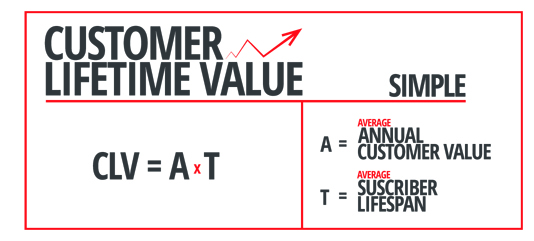Customer Lifetime Value (CLV) is an estimation of the future revenues that will be generated by each customer less the cost of goods sold, acquisition costs, and support/operational costs. A marketer can calculate CLV using either the simple, custom, or traditional equation method, but the most accurate estimate can be found by averaging these three values. The largest variation of CLV between SMS, Apps and Email will be the subscriber lifespan of each channel. There is also some variation between each channel due to the demographic preferences of using particular channels. You can increase the subscriber lifespan with well crafted customer engagement strategies which we will discuss in this article.

CLV is an important factor in your return on investment (ROI) calculation. The cost to acquire a customer (CAC) varies between Email, Applications, and SMS/MMS Messaging channels. The CAC can be calculated by taking the total cost of marketing spent and dividing it by the number of acquired customers. The ROI of any marketing or advertising campaign is determined by subtracting the CAC from the CLV. To maximize ROI a marketer must maximize the CLV while keeping the CAC to a minimum.

Email Marketing typically has a great return on investment due to its low ongoing cost of delivery coupled with a large potential audience. While many email marketing messages may be ignored or missed, the low cost of sending makes this approach cost effective for the customers that are reached. The lifetime value of an email subscriber is calculated using the lifetime of email subscription.
Mobile Applications or Apps communicate with users by sending quick, attention-grabbing, push notifications. A push notification can provide users with instructions, reminders, updates, and more. Additionally, many apps use loyalty programs to increase app use and engagement. The lifetime value of an app user is calculated using the lifetime the app is installed.
SMS/MMS Messaging allows brands to text their promotions to opted-in customers. Text messaging supports 2-way interaction making it the most engaging channel. With 94% of text messages being opened within five minutes of being sent according to Practical Ecommerce, messaging offers a great opportunity to reach customers. The lifetime value of an SMS/MMS user is calculated using the lifetime the customer is subscribed to the SMS campaign
The common thread between all three methods for calculating the CLV is the lifespan of the customer. Maximizing your subscriber lifespan is the easiest way to increase your customer lifetime value. Customer engagement techniques are used to increase the lifespan of a customer.
The three principles of customer engagement are:
- Sending messages at an acceptable frequency
- Sending messages at the right time
- Sending messages with appealing content
Frequency
Each channel has different optimal frequencies due to the level of engagement of the channel. Email has a higher optimal frequency than SMS because an email is less of an interruption. Sending too many text messages may cause customers to unsubscribe since they cannot easily be ignored like email. Push Notifications from Apps fall in-between SMS and email. They can be configured by the customer to alert in a way similar to SMS, but like email messages they can be put aside until later, and possibly be forgotten or cleared without reading them.
Timing
Most marketing emails are read in the morning or at night because many customers are unable to read their personal emails at work. Apps usage is also discouraged from being used during work hours. Due to the nature of SMS, these messages can be quickly observed at work without causing a noticeable lengthy distraction. But, if you sent an SMS to a person too early or late at night, they may feel it was an inappropriate time for this type of message. SMS messaging is best sent during the day or immediately before or after work.
Content
An email typically has a lot more content to read through, but due to over-saturation, emails are commonly skipped over and left unread. The length of an SMS is shorter, but is usually opened immediately and nearly all text messages are read within the first 3 minutes of receiving them. While it is difficult to fit much content into an SMS the content is much more likely to be read or clicked on.
The key to achieving your goals using these engagement channels is to leverage them in ways that best meet the customer’s expectations. By sending appealing content, at the right time, by the proper channel, and with an acceptable frequency, the lifespan of each customer will increase and so will your Customer Lifetime Value.
